Top Rankings
Wisner-Pilger School District ranks among the top 20% of public school district in Nebraska for:
Category
Attribute
Overall Rank
Highest overall rank (Top 10%)
Math Proficiency
Highest math proficiency (Top 10%)
Reading/Language Arts Proficiency
Highest reading/language arts proficiency (Top 10%)
For the 2025 school year, there are 2 public schools serving 453 students in Wisner-Pilger School District. This district's average testing ranking is 10/10, which is in the top 10% of public schools in Nebraska.
Public Schools in Wisner-Pilger School District have an average math proficiency score of 62% (versus the Nebraska public school average of 46%), and reading proficiency score of 62% (versus the 47% statewide average).
Minority enrollment is 21% of the student body (majority Hispanic), which is less than the Nebraska public school average of 38% (majority Hispanic).
Overview
This School District
This State (NE)
# Schools
2 Schools
1,100 Schools
# Students
453 Students
328,496 Students
# Teachers
42 Teachers
24,032 Teachers
Student : Teacher Ratio
11:1
11:1
District Rank
Wisner-Pilger School District, which is ranked within the top 10% of all 245 school districts in Nebraska (based off of combined math and reading proficiency testing data) for the 2021-2022 school year.
The school district's graduation rate of 80% has decreased from 90% over five school years.
Overall District Rank
#16 out of 246 school districts
(Top 10%)
(Top 10%)
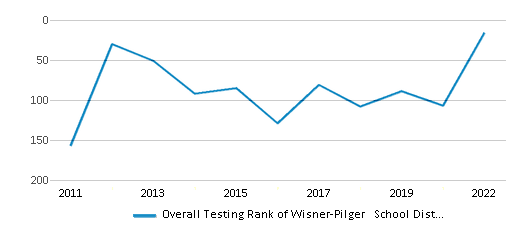
Math Test Scores (% Proficient)
60-64%
46%
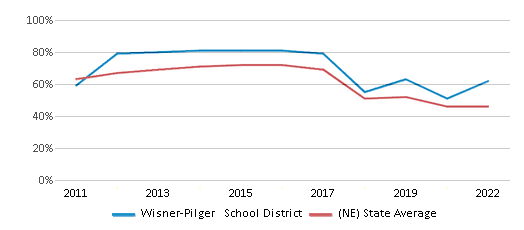
Reading/Language Arts Test Scores (% Proficient)
60-64%
47%
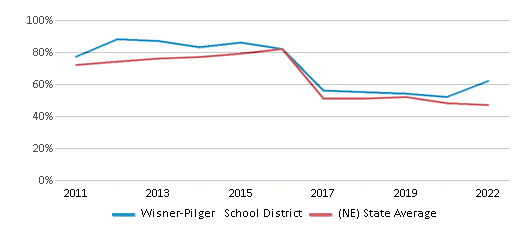
Science Test Scores (% Proficient)
65-69%
62%
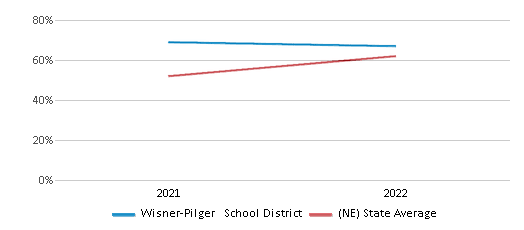
Graduation Rate
≥80%
87%
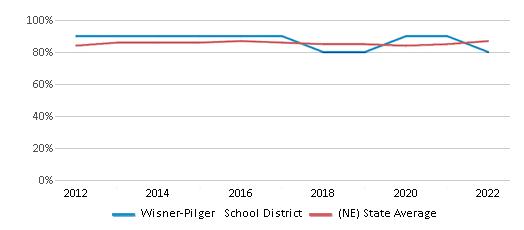
Students by Ethnicity:
Diversity Score
0.35
0.57
# American Indian Students
4 Students
4,353 Students
% American Indian Students
1%
1%
# Asian Students
2 Students
10,108 Students
% Asian Students
1%
3%
# Hispanic Students
74 Students
73,597 Students
% Hispanic Students
16%
22%
# Black Students
4 Students
21,317 Students
% Black Students
1%
7%
# White Students
358 Students
203,278 Students
% White Students
79%
62%
# Hawaiian Students
n/a
560 Students
% Hawaiian Students
n/a
n/a
# Two or more races Students
11 Students
15,283 Students
% of Two or more races Students
2%
5%
Students by Grade:
# Students in PK Grade:
44
19,504
# Students in K Grade:
37
22,318
# Students in 1st Grade:
40
22,898
# Students in 2nd Grade:
25
23,457
# Students in 3rd Grade:
30
23,201
# Students in 4th Grade:
38
23,506
# Students in 5th Grade:
28
23,198
# Students in 6th Grade:
30
23,396
# Students in 7th Grade:
24
23,395
# Students in 8th Grade:
25
24,061
# Students in 9th Grade:
39
25,222
# Students in 10th Grade:
25
25,356
# Students in 11th Grade:
39
23,606
# Students in 12th Grade:
29
25,378
# Ungraded Students:
-
-
District Revenue and Spending
The revenue/student of $19,038 is higher than the state median of $15,464. The school district revenue/student has stayed relatively flat over four school years.
The school district's spending/student of $17,309 is higher than the state median of $16,776. The school district spending/student has stayed relatively flat over four school years.
Total Revenue
$9 MM
$5,080 MM
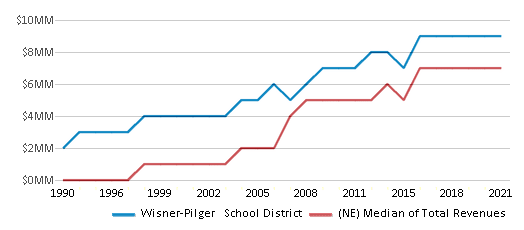
Spending
$8 MM
$5,511 MM
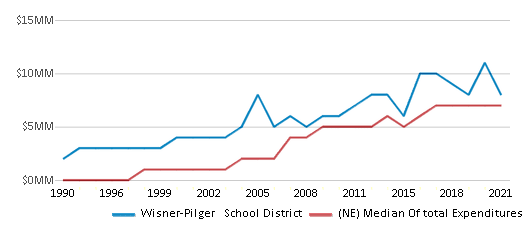
Revenue / Student
$19,038
$15,464
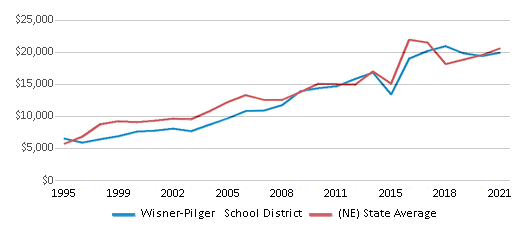
Spending / Student
$17,309
$16,776
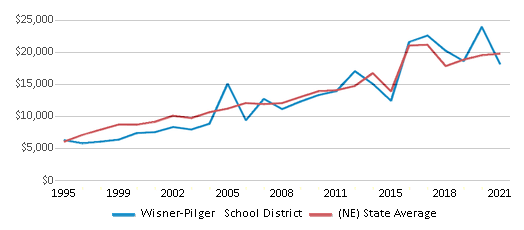
Best Wisner-Pilger School District Public Schools (2025)
School
(Math and Reading Proficiency)
(Math and Reading Proficiency)
Location
Grades
Students
Rank: #11.
Wisner-pilger Elementary School
(Math: 65-69% | Reading: 60-64%)
Rank:
Rank:
9/
Top 20%10
801 18th St
Wisner, NE 68791
(402) 529-6465
Wisner, NE 68791
(402) 529-6465
Grades: PK-6
| 272 students
Rank: #22.
Wisner-pilger High School
(Math: 55-59% | Reading: 60-64%)
Rank:
Rank:
8/
Top 30%10
801 18th St
Wisner, NE 68791
(402) 529-3249
Wisner, NE 68791
(402) 529-3249
Grades: 7-12
| 181 students
Frequently Asked Questions
How many schools belong to Wisner-Pilger School District?
Wisner-Pilger School District manages 2 public schools serving 453 students.
What is the rank of Wisner-Pilger School District?
Wisner-Pilger School District is ranked #17 out of 245 school districts in Nebraska (top 10%) based off of combined math and reading proficiency testing data for the 2021-2022 school year. This district ranks in the top 20% of Nebraska school districts for: Highest overall rank (Top 10%), Highest math proficiency (Top 10%) and Highest reading/language arts proficiency (Top 10%)
What is the racial composition of students in Wisner-Pilger School District?
79% of Wisner-Pilger School District students are White, 16% of students are Hispanic, 2% of students are Two or more races, 1% of students are American Indian, 1% of students are Asian, and 1% of students are Black.
What is the student/teacher ratio of Wisner-Pilger School District?
Wisner-Pilger School District has a student/teacher ratio of 11:1, which is lower than the Nebraska state average of 14:1.
What is Wisner-Pilger School District's spending/student ratio?
The school district's spending/student of $17,309 is higher than the state median of $16,776. The school district spending/student has stayed relatively flat over four school years.
Recent Articles

Year-Round Or Traditional Schedule?
Which is more appropriate for your child? A year-round attendance schedule or traditional schedule? We look at the pros and cons.

Why You Should Encourage Your Child to Join a Sports Team
Participating in team sports has a great many benefits for children, there is no doubt. In this article you will learn what those benefits are.

White Students are Now the Minority in U.S. Public Schools
Increasing birth rates among immigrant families from Asia and Central and South America, combined with lower birth rates among white families, means that for the first time in history, public school students in the United States are majority-minority. This shift in demographics poses difficulties for schools as they work to accommodate children of varying language abilities and socio-economic backgrounds.





